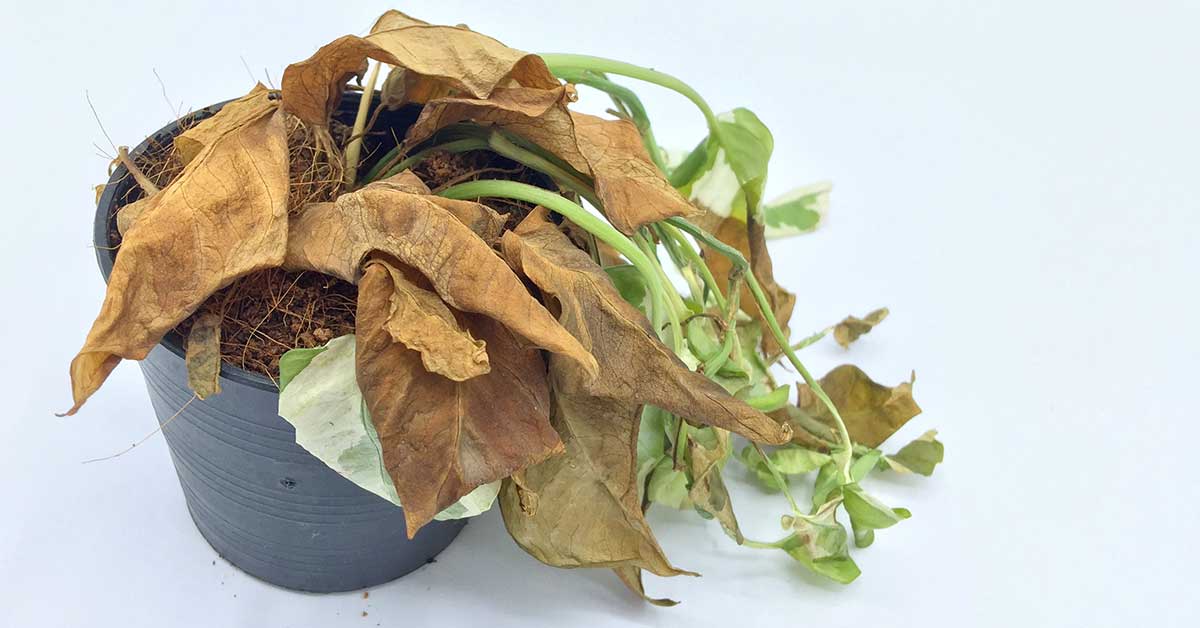Pothos is a popular houseplant for gardeners of all levels of expertise. This resilient plant is known for its glossy leaves and easy care requirements. Gardeners enjoy growing pothos for its vibrant foliage and its ability to thrive in a wide range of environments. However, if your pothos leaves are curling, it can be a cause of concern for even the most experienced gardeners. Curling leaves can be a sign of nutrient deficiencies, too much sunlight, or incorrect water levels, and it is important to identify the cause and make necessary adjustments. In this article, we’ll take a closer look at all the common reasons why pothos leaves curl.
Common reasons why your pothos leaves are curling
If you have curling pothos leaves, it’s probably one or more of the following 6 reasons, including too much heat, improper watering, and infection.
Improper watering
Underwatering causes pothos leaves to curl because the plant is not receiving enough water to maintain its turgidity. When the plant is not receiving enough water, the cells are unable to take in enough water to remain firm, and the leaves start to curl up as a response. Curling up is the plant’s way of protecting itself from the lack of water.
Similarly, overwatering causes pothos leaves to curl because it deprives the roots of oxygen and can cause them to rot. As the roots rot, they can no longer absorb the necessary nutrients and water, causing the plant to become stressed and the leaves to curl. This is because the plant is trying to reduce its water loss by retracting its leaves. Overwatering can also lead to fungal growth, which can further damage the roots and cause the leaves to curl.
Excessive heat
Excessive heat is another common reason that pothos leaves to curl. It can be easy to accidentally leave them in the path of a heating vent, for example, and as a self-defense mechanism, the leaves curl to prevent water loss. When the temperature rises, the water molecules inside the leaves become more active and try to escape the surface of the leaves. Unfortunately, this process can cause the cells of the leaves to become damaged, resulting in the leaves curling up to protect themselves. The curled leaves also prevent direct sunlight which in itself can also cause leaf curl.
Improper lighting
Improper lighting is a common cause of pothos leaves curling. Too much direct sunlight can cause the leaves to become scorched and curl up to protect themselves. If the plant is not getting enough light, the leaves will curl in an effort to maximize the available light. If the light is too strong, the leaves may become pale or yellow and curl. Additionally, if the plant is placed in a drafty area, the leaves may curl as a response to the cold air. In any of these scenarios, the best solution is to move the plant to an area with more appropriate lighting.
Overfertilizing
Another cause of pothos leaves curling is overfertilizing. If the plant is fed too much fertilizer, the leaves may curl as a result. The salt in the fertilizer can damage the plant’s roots, causing them to dry out and die. To combat this, it is best to not overfertilize the plant and to water it regularly. Doing so will help keep the soil moist and allow the plant to absorb the nutrients it needs without risking damage from overfertilization. Always follow the instructions on the fertilizer you purchase, and use a balanced 10-10-10 fertilizer.
Wilt
Bacterial wilt is a devastating disease caused by the bacterium Erwinia tracheiphila. The bacteria can enter the plant through wounds, such as those caused by pruning or insect damage. Once inside, the bacteria multiplies and clogs up the plant’s vascular system, which is responsible for transporting water and nutrients throughout the plant. As the plant’s vascular system is blocked, water and nutrients can no longer move freely throughout the plant, causing the leaves of the pothos to curl as they become dehydrated and starved of nutrients. Additionally, the bacteria can cause the leaves to discolor and the plant’s growth to slow or stop altogether, leading to plant death if left untreated.
Unfortunately, bacterial wilt is not curable. The best way to treat it is to remove the infected plant and dispose of it in a sealed plastic bag. If you want to avoid this in the future, make sure your pothos is watered with clean, chlorine-free water, and make sure it is not overwatered. You should also inspect your plant regularly and remove any yellow or wilted leaves.
Pests
Common pests that attack pothos include aphids and spider mites. Spider mites are a bit more common indoors than aphids. These pests don’t always cause curling leaves, but if you’re noticing damage and small webs on your pothos, it’s likely your plant is being infested by spider mites. There are a few ways you can address these pests on your pothos plant:
- Spraying the plant with neem oil: Neem oil is a natural insecticide and fungicide that can help kill spider mites on pothos.
- Dipping the plant in soapy water: Fill a large bucket with warm water and a few drops of mild dish soap and dip the pothos in it. This will help to kill any mites on the surface of the plant.
- Pruning the affected areas: Pruning off the affected areas of the pothos can help to reduce the spread of the mites and help the plant to recover.
- Introduce beneficial insects: Introducing beneficial insects such as ladybugs or lacewings can help to naturally control the population of spider mites. This might not make sense for indoor plants, though.













